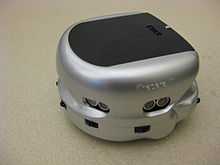Khepera mobile robot


The Khepera is a small (5.5 cm) differential wheeled mobile robot that was developed at the LAMI laboratory of Prof. Jean-Daniel Nicoud at EPFL (Lausanne, Switzerland) in the mid '90s. It was developed by Edo. Franzi, Francesco Mondada, André Guignard and others.
Small, fast, and architectured around a Motorola 68331, it has served researchers for 10 years, widely used by over 500 universities[1] [citation needed] worldwide.
Scientific impact
The Khepera was sold to a thousand research labs and featured on the cover of the 31 August 2000 issue of Nature.[2] It appeared again in a 2003 article .
A Google scholar search with khepera mobile robots returns 3400 hits . The Khepera helped in the emergence of evolutionary robotics .
Technical details
Original version
- Diameter: 55 mm
- Height: 30 mm
- Empty weight: 80 g
- Speed: 0.02 to 1.0 m/s
- Autonomy: 45 minutes moving
- Motorola 68331 CPU @ 16 MHz
- 256 KB RAM
- 512 KB EEPROM
- Running µKOS RTOS
- 2 DC brushed servo motors with incremental encoders
- 8 infrared proximity and ambient light sensors (SFH900)
2.0 Version
- Motorola 68331 CPU @ 25 MHz
- 512 KB RAM
- 512 KB Flash
- Improved batteries and sensors
Extensions
Several extension turrets exist for the Khepera, including:
- Gripper
- 1D or 2D camera, wire or wireless
- Radio emitter/receiver, low and high speed
- I/0
References
- Notes
- Mondada, F., Franzi, E., Guignard, A. (1999), The Development of Khepera. In proceedings of First International Khepera Workshop, Paderborn, 10–11 December 1999. PDF BibTex EPFL Infoscience entry
External links
| Wikimedia Commons has media related to Khepera mobile robot. |
- Homepage – K-Team, the company which sells the Khepera robots
- The Khepera-Lisp Interface (KHLI) – library for controlling Khepera from Allegro Common LISP
- Khepera Simulator – A 2D simulator for the Khepera mobile robot
- Webots – A commercial software that simulates and allows cross-compilation and remote control of the Khepera and other robots
- khepera.cfg – Khepera configuration file for Player Project robot simulator
- YAKS at Freecode – Yet Another Khepera Simulator
- Khepera III Toolbox – A software toolbox for the Khepera III robot
- KiKS is a Khepera Simulator – Matlab based Khepera/Khepera II simulator